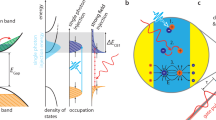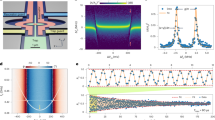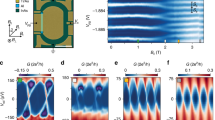Abstract
The high-speed, high-accuracy transport of single electrons in nanoscale devices is predicted to underpin future electronics. A key and topical application is the development of a fundamental standard of electrical current linking the ampere to the elementary charge and frequency. For a practical standard, currents at the nanoampere level are required, corresponding to gigahertz transport frequencies. Recent research has concentrated on transport using Coulomb blockade techniques. However, the tunnelling time of the electrons in such devices limits the operation to a few megahertz. We present a different pumping mechanism of single charges, whereby electrons ‘surf’ as particles on a time-dependent potential instead of tunnelling through the barriers as waves. This potential is created by two phase-shifted sinusoidal signals applied directly to metallic finger gates on an etched GaAs/AlGaAs quantum wire. Pumping accurate to better than 10−4, at a frequency up to 3.4 GHz, is reported with this approach.
This is a preview of subscription content, access via your institution
Access options
Subscribe to this journal
Receive 12 print issues and online access
$209.00 per year
only $17.42 per issue
Buy this article
- Purchase on Springer Link
- Instant access to full article PDF
Prices may be subject to local taxes which are calculated during checkout




Similar content being viewed by others
References
Mills, I. M., Mohr, P. J., Quinn, T. J., Taylor, B. N. & Williams, E. R. Redefinition of the kilogram, ampere, kelvin and mole: A proposed approach to implementing CIPM recommendation 1 (ci-2005). Metrologia 43, 227–246 (2006).
Geerligs, L. J. et al. Frequency-locked turnstile device for single electrons. Phys. Rev. Lett. 64, 2691–2694 (1990).
Anderegg, V. F. et al. Frequency-determined current with a turnstile device for single electrons. Physica B 165–166, 61 (1990).
Kouwenhoven, L. P., Johnson, A. T., van der Vaart, N. C. & Harmans, C. J. P. M. Quantized current in a quantum-dot turnstile using oscillating tunnel barriers. Phys. Rev. Lett. 67, 1626 (1991).
Devoret, M. H., Esteve, D. & Urbina, C. Single-electron transfer in metallic nanostructures. Nature 360, 547–553 (1992) http://dx.doi.org/10.1038/360547a0.
Pothier, H., Lafarge, P., Urbina, C., Esteve, D. & Devoret, M. H. Single-electron pump based on charging effects. Europhys. Lett. 17, 249–254 (1992).
Keller, M. W., Martinis, J. M., Zimmerman, N. M. & Steinbach, A. H. Accuracy of electron counting using a 7-junction electron pump. Appl. Phys. Lett. 69, 1804 (1996).
Keller, M. W., Eichenberger, A. L., Martinis, J. M. & Zimmerman, N. M. A capacitance standard based on counting electrons. Science 285, 1706 (1999).
Piquemal, F. et al. Fundamental electrical standards and the quantum metrological triangle. Comptes Rendus Phys. 5, 857–879 (2004).
Shilton, J. M. et al. High-frequency single-electron transport in a quasi-one-dimensional GaAs channel induced by surface acoustic waves. J. Phys. Condens. Matter 8, L531–L539 (1996).
Thornton, T. J., Pepper, M., Ahmed, H., Andrews, D. & Davies, G. J. One-dimensional conduction in the 2d electron gas of a GaAs–AlGaAs heterojunction. Phys. Rev. Lett. 56, 1198–1201 (1986).
Fujiwara, A., Zimmerman, N. M., Ono, Y. & Takahashi, Y. Current quantization due to single-electron transfer in Si-wire charge coupled devices. Appl. Phys. Lett. 84, 1323 (2004).
Moskalets, M. & Büttiker, M. Floquet scattering theory of quantum pumps. Phys. Rev. B 66, 205320 (2002).
Nagamune, Y. et al. Single electron transport and current quantization in a novel quantum dot structure. Appl. Phys. Lett. 64, 2379 (1994).
Robinson, A. M. & Barnes, C. H. W. Classical dynamics of electrons in quantized-acoustoelectric-current devices. Phys. Rev. B 63, 165418 (2001).
Flensberg, K., Niu, Q. & Pustilnik, M. Nonadiabaticity and single-electron transport driven by surface acoustic waves. Phys. Rev. B 60, R16291–R16294 (1999).
Aizin, G. R., Gumbs, G. & Pepper, M. Screening of the surface-acoustic-wave potential by a metal gate and the quantization of the acoustoelectric current in a narrow channel. Phys. Rev. B 58, 10589–10596 (1998).
Gumbs, G., Aizin, G. R. & Pepper, M. Coulomb interaction of two electrons in the quantum dot formed by the surface acoustic wave in a narrow channel. Phys. Rev. B 60, R13954–R13957 (1999).
Zimmerman, N. M., Hourdakis, E., Ono, Y., Fujiwara, A. & Takahashi, Y. Error mechanisms and rates in tunable-barrier single-electron turnstiles and charge coupled devices. J. Appl. Phys. 96, 5254 (2004).
Janssen, T. J. B. M. & Hartland, A. Accurate measurement of currents generated by single electrons transported in a one-dimensional channel. IEEE Proc.-Sci. Meas. Technol. 147, 174–176 (2000).
Ebbecke, J., Fletcher, N. E., Ahlers, F., Hartland, A. & Janssen, T. J. B. M. Study on the limitations of the quantized acoustic current technique at PTB and NPL. IEEE Trans. Instrum. Meas. 52, 594 (2003).
Barnes, C. H. W., Shilton, J. M. & Robinson, A. M. Quantum computation using electrons trapped by surface acoustic waves. Phys. Rev. B 62, 8410 (2000).
Gumbs, G. & Abranyos, Y. Quantum entanglement for acoustic spintronics. Phys. Rev. A 70, 050302 (2004).
Foden, C. L., Talyanskii, V. I., Milburn, G. J., Leadbeater, M. L. & Pepper, M. High-frequency acousto-electric single-photon source. Phys. Rev. A 62, 011803 (2000).
Gell, J. R. et al. Surface-acoustic-wave-driven luminescence from a lateral p–n junction. Appl. Phys. Lett. 89, 243505 (2006).
Acknowledgements
We gratefully acknowledge A. Robinson, S. Amakawa, V. Kashcheyevs and H. W. Schumacher for useful discussions. Acknowledgment also goes to K. Cooper and J. Griffiths for advice and work on the fabrication of the devices. This work was supported by the UK National Measurement System and the EPSRC. L.L. acknowledges support by the National Nature Science Foundation of China under grant No 60436010.
Author information
Authors and Affiliations
Corresponding author
Ethics declarations
Competing interests
The authors declare no competing financial interests.
Rights and permissions
About this article
Cite this article
Blumenthal, M., Kaestner, B., Li, L. et al. Gigahertz quantized charge pumping. Nature Phys 3, 343–347 (2007). https://doi.org/10.1038/nphys582
Received:
Accepted:
Published:
Issue Date:
DOI: https://doi.org/10.1038/nphys582
This article is cited by
-
Zero-average Bias Bidirectional Single-electron Current Generation in a Hybrid Turnstile
Journal of Low Temperature Physics (2023)
-
Self-oscillating pump in a topological dissipative atom–cavity system
Nature (2022)
-
Quantum interference effects in multi-channel correlated tunneling structures
Scientific Reports (2021)
-
Picosecond detection of electron motion
Nature Nanotechnology (2019)
-
Continuous-variable tomography of solitary electrons
Nature Communications (2019)



